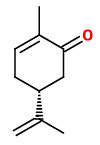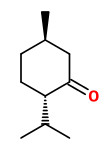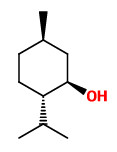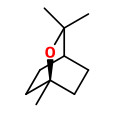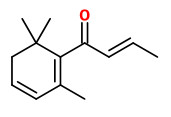Mentha spicata L. - Lamiaceae - spearmint, common green mint, Krauseminze, Grüne Minze
Mentha spicata L. var. crispa (Benth.) Danert = Mentha spicata L. subsp. spicata = Mentha viridis (L.) L. = Mentha crispa L.
Mentha microphylla K. Koch = Mentha spicata L. subsp. condensata (Briq.) Greuter & Burdet = Mentha tomentosa d’Urv.
http://www.ars-grin.gov/cgi-bin/npgs/html/taxon.pl?24082
Perennial herb, 30-60cm tall, native to Southeast Europe and West Asia, cultivated worldwide; stems quadrangular; leaves sessile or subsessile, ovate-oblong to oblong-lanceolate, margin irregularly serrate, base broadly cuneate, apix acute; cylindric terminal spikes of white to pink or purplish flowers. http://www.efloras.org/florataxon.aspx?flora_id=5&taxon_id=200019821
„High enantiometic purity of (R)(-)-carvone was detected in the oils of spearmint from various sources.“
[Chiral GC analysis of (S)(+)‐and (R)(−)‐carvone with high enantiomeric purity in caraway, dill and spearmint oils., Ravid, U., Putievsky, E., Katzir, I., Weinstein, V., Ikan, R., Flavour and fragrance journal, 7(5), 1992, 289-292]
Spearmint essential oil is dominated by carvone (37.7%), menthol (16.1%), limonene (15.0%), and menthone (9.7%), with smaller abundances of isomenthone (4.4%), neomenthol (2.4%), menthyl acetate (1.4%) and cis-dihydrocarvone (1.1%). Menthofuran was not found.
[Application of Comprehensive Two-Dimensional Gas Chromatography (GC× GC) to the Qualitative Analysis of Essential Oils. Dimandja, J. M. D., Stanfill, S. B., Grainger, J., Patterson Jr, D. G., Journal of High Resolution Chromatography, Vol.23(3), 2000, 208-214]
The essential oil of the leaves and twigs of nana mint (Mentha spicata L. ssp.spicata, syn.Mentha viridis L. var.nanah) is characterized by higher amounts of (-)-limonene (14-31%), 1,8-cineole (0.8-6.7%; cineole:limonene <0.5), (-)-carvone (53-65%), minor amounts of menthol (<0.5%), and the absence of isopulegole (M.arvensis!) and menthofuran (M.piperita!).
[Wolz, Dietmar, and Gerhard Buchbauer. Aromatherapie in Wissenschaft und Praxis. Ed. Wolfgang Steflitsch. Stadelmann, 2013]
„…(-)-carvone was the most potent odorant in all three spearmint oils. In Native spearmint oil, other potent odorants included eugenol (clove), ethyl-2-methylbutyrate (fruity), β-damascenone (applesauce), (3E,5Z)-1,3,5-undecatriene (tape), and methional (cooked potato). In Scotch spearmint oil, other potent odorants were eugenol, (3E,5Z)-1,3,5-undecatriene, β-damascenone, isoeugenol, and an unknown minty odorant (RIWAX= 1719). In Macho mint oil, additional potent odorants included eugenol, (3E,5Z)-1,3,5-undecatriene, ethyl-2-methylbutyrate, and β-damascenone. Important odorants which remain unknown include two minty odorants (RIWAX= 1425 and 1719), a bread-like odorant (RIWAX= 1434), and an insect repellent-like odorant (RIWAX= 2366)… some compounds, such as dimethyl trisulfide and 3-methyl-2-butene-1-thiol, had high FD factors yet were not detectable by GC-MS. This can be attributed to the low odor thresholds of these compounds. The threshold for dimethyl trisulfide is 0.01 parts per billion, and the threshold for 3-methyl-2-butene-1-thiol is 1.2 parts per trillion (Buttery et. al., 1976; Fritsch and Schieberle, 2005). These trace potent odorants are typically overlooked due to their low concentrations, yet are significant to the overall flavor of spearmint oils.“
[Kelley, Lauren. „Analysis of potent odorants in spearmint oils.“ (2014)] PDF
Aroma extract dilution analysis (AEDA) of spearmint oils showed (R)-(−)-carvone as the most potent odorant. Additional predominant odorants included eugenol, ethyl (S)-(+)-2-methylbutanoate, (E)-β-damascenone, and (3E,5Z)-1,3,5-undecatriene. „Among the compounds quantitated, those with the highest OAVs were (R)-(−)-carvone, 1,8-cineole, (E,Z)-2,6-nonadienal, (E)-β-damascenone, and (3E,5Z)-1,3,5-undecatriene.“
[Kelley, Lauren E., and Keith R. Cadwallader. „Identification and quantitation of potent odorants in spearmint oils.“ Journal of Agricultural and Food Chemistry (2017)]
„While L-carvone represents about 60-75% of spearmint oil, it doesn't provide the distinct odor and flavor of the natural spearmint oil, which in addition to L-carvone contains carveol (0.4-0.7%), carvyl acetate (1-2%), dihydrocarveol (0.1-0.2%), and dihydrocarvyl acetate (0.3-0.4%) among many other components… L-carvyl acetate and L-dihydrocarvyl acetate, are essential for creating the distinct spearmint flavor.“
[Kolomeyer, Gennadiy G.; Ferone, Douglas. Spearmint flavor enhancer. U.S. Patent Application Nr. 10/119,096, 2018] US10119096B2
„Twenty-one female hirsute patients, 12 with polycystic ovary syndrome and 9 with idiopathic hirsutism were included to the study. They were took a cup of herbal tea which was steeped with M. spicata for 5 days twice a day in the follicular phase of their menstrual cycles. After treatment with spearmint teas, there was a significant decrease in free testosterone and increase in luteinizing hormone, follicle-stimulating hormone and estradiol. There were no significant decreases in total testosterone or dehydroepiandrostenedione sulphate levels. Spearmint can be an alternative to antiandrogenic treatment for mild hirsutism. Further studies are needed to test the reliability of these results and the availability of spearmint as a drug for hirsutism.“
[Effect of spearmint (Mentha spicata Labiatae) teas on androgen levels in women with hirsutism. Akdoğan, M., Tamer, M. N., Cüre, E., Cüre, M. C., Köroğlu, B. K., Delibaş, N., Phytotherapy Research, Vol.21(5), 2007, 444-447]
„Forty one of 42 patients completed the study. Free and total testosterone levels were significantly reduced over the 30 day period in the spearmint tea group (p < 0.05). LH and FSH also increased (p < 0.05). Patient's subjective assessments of their degree of hirsutism scored by the modified DQLI were significantly reduced in the spearmint tea group (p < 0.05). There was, however, no significant reduction in the objective Ferriman-Galwey ratings of hirsutism between the two trial groups over the trial duration (p = 0.12). There was a clear and significant alteration in the relevant hormone levels. This is associated clinically with a reduction in the self-reported degree of hirsutism but unfortunately not with the objectively rated score.
It was demonstrated and confirmed that spearmint has antiandrogen properties, the simple fact that this does not clearly translate into clinical practice is due to the relationship between androgen hormones and follicular hair growth and cell turnover time. Simply put, the study duration was not long enough. The original studies from Turkey were in fact only 5 days long. The time taken for hirsutism to resolve is significant and a much longer future study is proposed as the preliminary findings are encouraging that spearmint has the potential for use as a helpful and natural treatment for hirsutism in PCOS.“
[Spearmint herbal tea has significant anti‐androgen effects in polycystic ovarian syndrome. a randomized controlled trial. Grant, P., Phytotherapy Research, Vol.24(2), 2010, 186-188]
Investigating its pharmacological effects in the guinea pig ileum, „The effect of (−)-carvone was compared with that of the classical calcium channel blocker (CCB) verapamil… (−)-carvone reduced the contraction induced by high K+ and was almost 100 times more potent than verapamil. Thus, (−)-carvone showed a typical and potent CCB-like action. Many effects described for both (−)-carvone and spearmint oil can be explained as a CCB-like mode of action.“
[Souza, Fábia Valéria M., et al. „(−)-Carvone: Antispasmodic effect and mode of action.“ Fitoterapia 85 (2013): 20-24]

Mentha spicata L. subsp. spicata as Mentha viridis
Masclef, A., Atlas des plantes de France, vol.3, t.252 (1893) plantgenera.org

Mentha spicata, North Yorkshire, England (2025) © sophspotsspecies CC BY-SA 4.0 inaturalist.org
